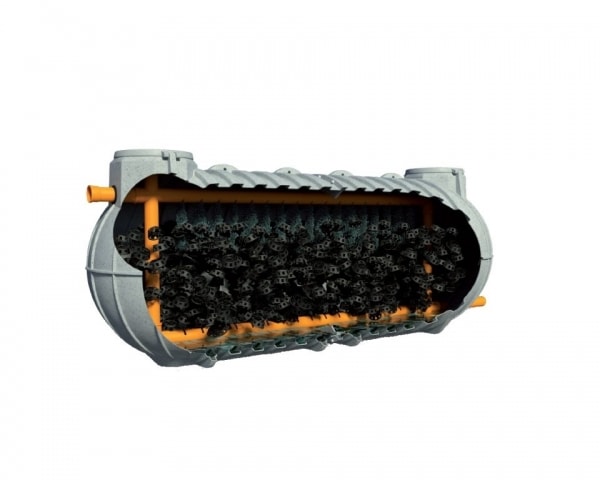AEROBIC/ANAEROBIC PERCOLATING FILTER INFINITANK
Technical characteristics:
A percolating filter is a biological reactor, inside which the micro- organisms that purify the effluent develop on the surface of special bulk fill material (filter media). The uniform distribution of the effluent through the filter guarantees maximum contact between the organic material to purify and the biological film covering the spheres making up the fill material. The spheres of the filter media are manufactured in polypropylene and are designed to provide a large surface area available for bacterial micro-organisms to take root. In particular, the spheres used provide a surface area per unit volume of filter media of 140 m2/m3, much higher than the traditional stone fill material, with voids accounting for over 90% of the volume. This solution minimises the risk of clogging the bed and also guarantees an improved circulation of air through the bed of the aerobic filter. Percolating filters allow good purification performance without any energy overheads, with management costs limited to the occasional cleaning of the plant. The sizing of percolating filters for an average domestic effluent refers to the organic load factor (kgBOD /m3d) with which the filter is fed. This parameter is the ratio between the organic load at the inlet (kgBOD d) and the volume of the filter bed. Rototec filters are designed to operate with medium-low organic load factors (kgBOD /m3d). This guarantees a good margin of safety, with respect to fluctuations in inlet flow, and a limited produc-
Application:
Treatment of domestic raw sewage for secondary treatment at low volumetric hydraulic and organic load by means of adhered biomass aerobic digestion.
Use and maintenance:
The development of the films on the filter media can over time excessively dirty the filter, with the resulting risk of solids being discharged with the treated effluent. In order to avoid an excessively turbid discharge it is advisable to inspect and clean the filter at least once a year. These operations are normally carried out as part of the Imhoff tank inspection and emptying operations. Cleaning is performed by thoroughly washing the filter bed, backwashing where necessary, paying particular attention to remove any accumulations in the inlet and outlet pipes. It should be remembered that in order for the percolating filter to function correctly, the effluent must first be subjected to primary sedimentation treatment in an Imhoff tank or similar installed upstream of the filter.In the case of aerobic percolating filters, it is necessary to install a sedimentation tank downstream which will settle out any sludge residues released by the filter.
Installation: Carefully follow the “INFINITANK INSTALLATION INSTRUCTIONS” provided by ROTOTEC.
This post is also available in: Italian French


